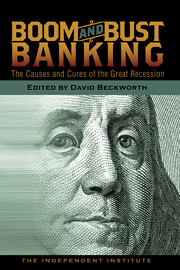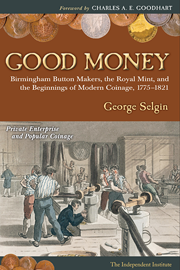Let’s begin with a little word association. Here goes: “deflation.” Let’s see: default, panic, crisis, credit crunch, layoffs, foreclosures, unemployment, recession, depression . . . Great Depression.
Now there was a deflation. Between the October 1929 stock market crash and FDR’s inauguration in March 1933, the general price level fell 25 percent, while wholesale prices fell a whopping 37 percent. As prices dropped, so did employment: by the time prices reached bottom around March 1933, a quarter of the U.S. labor force was out of work. Nor did falling prices help the economy to right itself. Instead, the deflation only seemed to make things worse, in part by increasing the burden of debt. The lower prices went, the more the real value of every dollar owed went up. Defaults piled up, causing more banks to fail, making credit even scarcer, which meant that there was even less money around, so prices had to fall further. Economists call this a debt-deflation spiral, and they agree that it’s the last thing an economy needs.
Not surprisingly, the U.S. emerged from the trauma of the Great Depression with a severe case of deflation anxiety that still has us in its grip. Fear of falling prices is so great that the inflation rate has only to dip below 2 percent—a rate at which prices would still double in 36 years—to get pundits chanting about economic collapse and the Fed’s Board of Governors stoking money into the economy like their lives depended on it.
Needless to say, if the inflation rate ever manages, despite the Fed’s efforts, to fall below zero, utter panic takes hold. So when the Bureau of Labor Statistics reported negative monthly inflation three times in a row starting last October, the press went to town with reports of gloom and doom, and the Federal Reserve Board took the unprecedented step of giving money away by lowering the federal funds rate—the overnight rate for inter-bank loans—all the way to zero. Who can blame it? After all, the circumstances surrounding the recent deflation bear an eerie resemblance to those surrounding the downward plunge of the early 1930s, with falling prices going hand-in-hand with declining sales and rising unemployment and loan defaults. These events are precisely the things that can fuel a downward economic spiral—which the Fed is supposed to prevent.
And yet, for all the harm it has done, and might still do, deflation gets a bad rap. Although the Fed and other central banks don’t seem to realize it, deflation isn’t always as dangerous as it was in the 1930s. There’s another kind of deflation that can actually be a good thing. And when central banks stand in the way of this good sort of deflation, the results can be disastrous. The current bust is a case in point.
We’ll come back to that. But first, some more word association. The word this time is “innovation.” How about research and development, new technology, efficiency gains, cost-cutting, price-cutting . . . deflation.
Yes, deflation again. But this isn’t the bad deflation of the 1930s. It comes not from consumers having less money to spend but from them being confronted with more to spend it on. “Bad” deflation happens when demand shrinks; “good” deflation happens when supply expands.
The difference between the two sorts of deflation couldn’t be more basic. Most people grasp it without a hitch. Unfortunately, economists seem to be the exception, perhaps because of their obsession with the Great Depression and zeal to avoid repeating it. Nor has their understanding been aided by the fact that none of them has ever actually witnessed the good sort of deflation.
Yet good deflation isn’t just hypothetical. For much of the 19th century, when the gold standard prevented central banks from printing money willy-nilly, prices fell more often than they rose, and people considered that tendency to be perfectly natural. After all, technology was improving, so goods cost less to produce. Why shouldn’t prices reflect that reality? From 1873–96, for instance, prices in most gold-standard countries fell at an average rate of about 2 percent a year, while real output grew at correspondingly healthy rates of between 2 and 3 percent, thanks largely to productivity gains. That isn’t to say that there weren’t occasional crises—there were, and some involved a dose of bad deflation, driven by temporary lulls in lending and spending. But the general trend of spending was up, while the downward trend of prices remained within the bounds of underlying productivity gains and was for that reason perfectly benign: businesses could afford to sell their products for less as long as it was costing less to make them.
Of course technological improvements didn’t come to a halt, much less give way to technological backsliding, after the 1930s. On the contrary, the post-Depression era has been witness to some of the U.S. economy’s most dramatic productivity gains. Yet the Consumer Price Index, instead of falling along with those gains, has risen dramatically and with scarcely a break. Even 2008 saw a slight rise in the CPI, despite the last several months’ deflation, and if 2009 turns out to be a deflationary year, it will be the first since 1954. Whatever else is driving price movements, it’s no longer underlying changes in real unit production costs.
The complete disconnection of price movements from underlying real cost changes in modern times is a measure of contemporary monetary authorities’ laxness when it comes to preventing inflation, combined with their refusal to acknowledge the theoretical possibility of a benign deflation. That denial rests on sloppy economics that insist on conflating the consequences of good, supply-driven deflation with those of its bad, demand-driven counterpart.
Many experts insist, for example, that to allow any deflation is to risk putting people out of work because “sticky” wages and salaries will fail to keep pace with falling prices, causing rising labor costs to put a squeeze on employers. That’s a fine argument against bad deflation. But if output prices only decline when goods are being produced more efficiently, there’s no need for wages and salaries to fall along with them. On the contrary, productivity gains mean higher real wages and salaries in equilibrium, and the easiest way to achieve that equilibrium is to leave wages alone while letting the price level fall. When output prices are held up instead, money wages and salaries have to rise.
Next, consider the claim that deflation, or at least unexpected deflation, rewards creditors at the expense of debtors, increasing the likelihood of foreclosures. That’s true enough for bad deflation, when earnings are shrinking all around: with fixed loans to pay, something has to give, usually the loan payment. But the same isn’t true for good deflation. After all, if prices are falling because goods are becoming more abundant, why shouldn’t creditors get to enjoy that along with other income earners? Imagine that the extra goods drop like manna from heaven, with debtors and creditors grabbing like shares. What cause do debtors have for regretting the loans they negotiated? None at all. So far as theory can predict, if everyone had anticipated the falling price of manna, the terms of lending would have been no different. The debtors end up with more than before, but so what? The creditors can afford it.
Then there’s the claim that, if they permit deflation, the monetary authorities risk working themselves into a corner, like the present one, with short-term lending rates bottomed out at zero and no scope for any further easing of credit, at least by conventional means. That scenario raises the specter of an invincible deflationary spiral. But here again, while that’s plausible enough when bad deflation is in play, it’s quite implausible when all that’s happening is good deflation because a good deflation rate never exceeds an economy’s rate of productivity growth, and that rate itself sets a lower bound to equilibrium real rates of interest. It follows that as long as only good deflation is permitted, equilibrium nominal lending rates—real rates minus any anticipated deflation—never venture south of zero.
In sum, there’s no reason to fear good deflation or confuse it with its bad cousin. On the other hand, there is reason to fear central bank policies that prevent good deflation—especially those that cause prices to go up while production costs are going down. Such efforts trigger booms and busts.
Whenever productivity advances, so must real earnings. It follows that if output prices aren’t allowed to go down, input prices must go up. The same money creation that serves to prop up the prices of goods also puts upward pressure on the prices of labor and other factors of production. But as deflation-bashers never tire of reminding us, input prices are “sticky.” This means that, in the short run, money being pumped into the economy serves not to raise wages but to boost profits. And high profits, if projected into the future, boost asset prices. Yet the high profits aren’t sustainable because, although speculators may not know it, they are due to give way to higher costs. Voilà—a boom-bust cycle, and one that’s likely to catch investors off guard because the boom takes place in a setting of low inflation.
If this sounds familiar that’s because the Fed has taken us through three such cycles in a row, starting with the Reagan boom of the mid-’80s, followed by the dot-com boom of the ’90s, and ending with the current catastrophe. Besides being the worst of the bunch, the latest episode comes with its own ironic twist, for it illustrates how, by insisting on thwarting good deflation, a central bank can end up inadvertently provoking deflation of the very worst kind. This brings us to the moral of the story: a little good deflation every day helps keep bad deflation away.
This article first appeared in The American Conservative, www.amconmag.com.









